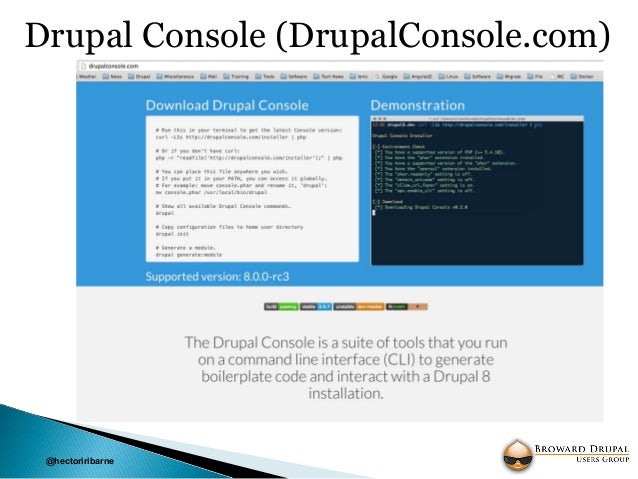


- #INSTALL DRUPAL CONSOLE DRUPAL 9 INSTALL#
- #INSTALL DRUPAL CONSOLE DRUPAL 9 GENERATOR#
- #INSTALL DRUPAL CONSOLE DRUPAL 9 FULL#
- #INSTALL DRUPAL CONSOLE DRUPAL 9 CODE#
Now you should see extra tabs such as Hooks, Plugins, “Entity types”, etc… Then click on “Save basic information”.ģ. On the “Add module” screen, enter in a readable name for your module and define its dependencies if required. Go to Configuration, Module Builder and click on “Add module”.Ģ. Now that we have everything set up, let’s go ahead and create a module.ġ.
#INSTALL DRUPAL CONSOLE DRUPAL 9 CODE#
After the code analysis is complete, you can see the results. Click on the Analyse code tab, then “Perform code analysis”.ĥ.
#INSTALL DRUPAL CONSOLE DRUPAL 9 INSTALL#
When you first install the module, it’ll need to analyse your Drupal site and collect information about components and hooks.Ĥ. Go to Configuration, then click on Module Builder in the Development section.ģ. Go to Extend, find “Module Builder” and install it.Ģ. NOTE: This module should NEVER be installed on a production site. To get started, run the following Composer command: composer require drupal/module_builder Module Builder is an actual module which needs to be downloaded and installed into your Drupal site. Now let’s look at another way you can generate scaffolding code and that’s using Module Builder. So far we’ve looked at using CLI tools to generate code Drupal Console and Drush. Once complete you should have a form in src/Form. So if you just created a module make sure you install it first before generating a form. Just note, the module needs to be installed for it to be found by Drush. Similar to Drupal Console, the first prompt is to know which module you want to add the form into. This will create a form class as well as a route for the form. Run the following: drush generate form-simple Let’s now use Drush to generate a form which will be added to the module we just created. First, create the module then add other components into the module such as a form or block. With Drupal Console, you can’t create other plugins while creating the module. Would you like to create settings form? : Would you like to create event subscriber? : Would you like to create permissions.yml file? : Would you like to create libraries.yml file? : The difference between creating a module using Drush or Drupal Console is that when you use Drush you get asked if you want to create a libraries.yml, permissions.yml, block, controller, etc… Would you like to create install file? : Same as Drupal Console, you get prompted to enter in things such as the module name, machine name, etc… Module name: Similar to what we did in the previous section let’s generate a module. Run `drush generate ` and answer a few questions in order to write starter code to your project.Ĭomposer (composer.json) Generates a composer.json file To see all the commands, just run the following: drush generate Drush generate 9.7.1 Drush 9 integrates with the project so you won’t have to set anything up.
#INSTALL DRUPAL CONSOLE DRUPAL 9 GENERATOR#
It uses the Drupal Code Generator project to generate the code. Drush never had the ability to generate code until version 9 (correct me if I’m wrong about this).
#INSTALL DRUPAL CONSOLE DRUPAL 9 FULL#
You’d use Drush to rebuild the site cache, install or uninstall a module, install a full site and so much more. In my opinion, it was a game-changer for Drupal. Drushĭrush was the original CLI tool for Drupal. So that’s how you use Drupal Console to create a module and implement a custom block in the module. The next three prompts are important: plugin class name, plugin label and plugin id. Just start typing in the name of the module and it’ll autocomplete on the name. In the first prompt, you’ll be asked which module you want to add the block into. Now let’s look at generating a block in the module. In the last section, we created a module using Drupal Console. Then fill out the prompts and you’re good to go. When you’re working on a Drupal site you’re always creating custom modules, so let’s create one. Now let’s go ahead and generate a module using Drupal Console. Generate:cache:context (gcc) Generate a cache context Generate:breakpoint (gb) Generate breakpoint Generate:authentication:provider (gap) Generate an Authentication Provider Generate:ajax:command (gac) Generate & Register a custom ajax command vendor/bin/drupal generateĭrupal generate Drupal Console version 1.9.1Īvailable commands for the "generate" namespace:

To see all the available generate commands just run. It’s similar to Drush, which is another CLI tool, but when it was first released the biggest benefit was its ability to generate code (Drush can now generate code as of version 9). You can use Drupal Console to rebuild site cache, import configuration changes and generate code, this is what we’re interested in. It’s used to interact with a Drupal site using a command line interface. Drupal Console is a command line tool (CLI) tool for Drupal 8.


 0 kommentar(er)
0 kommentar(er)
